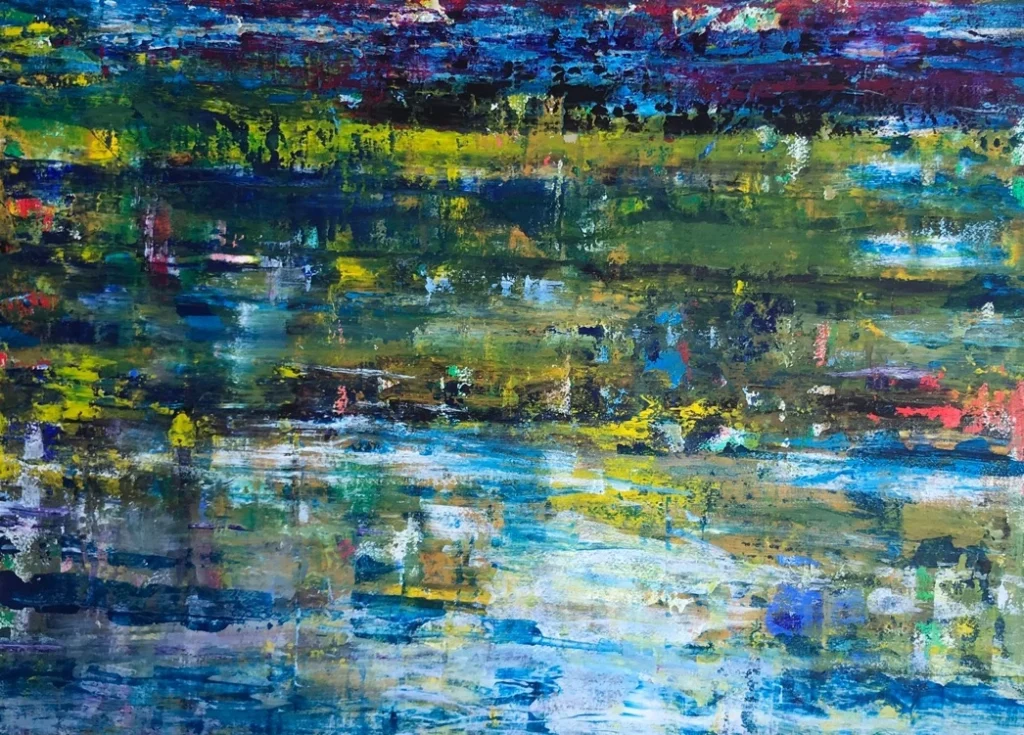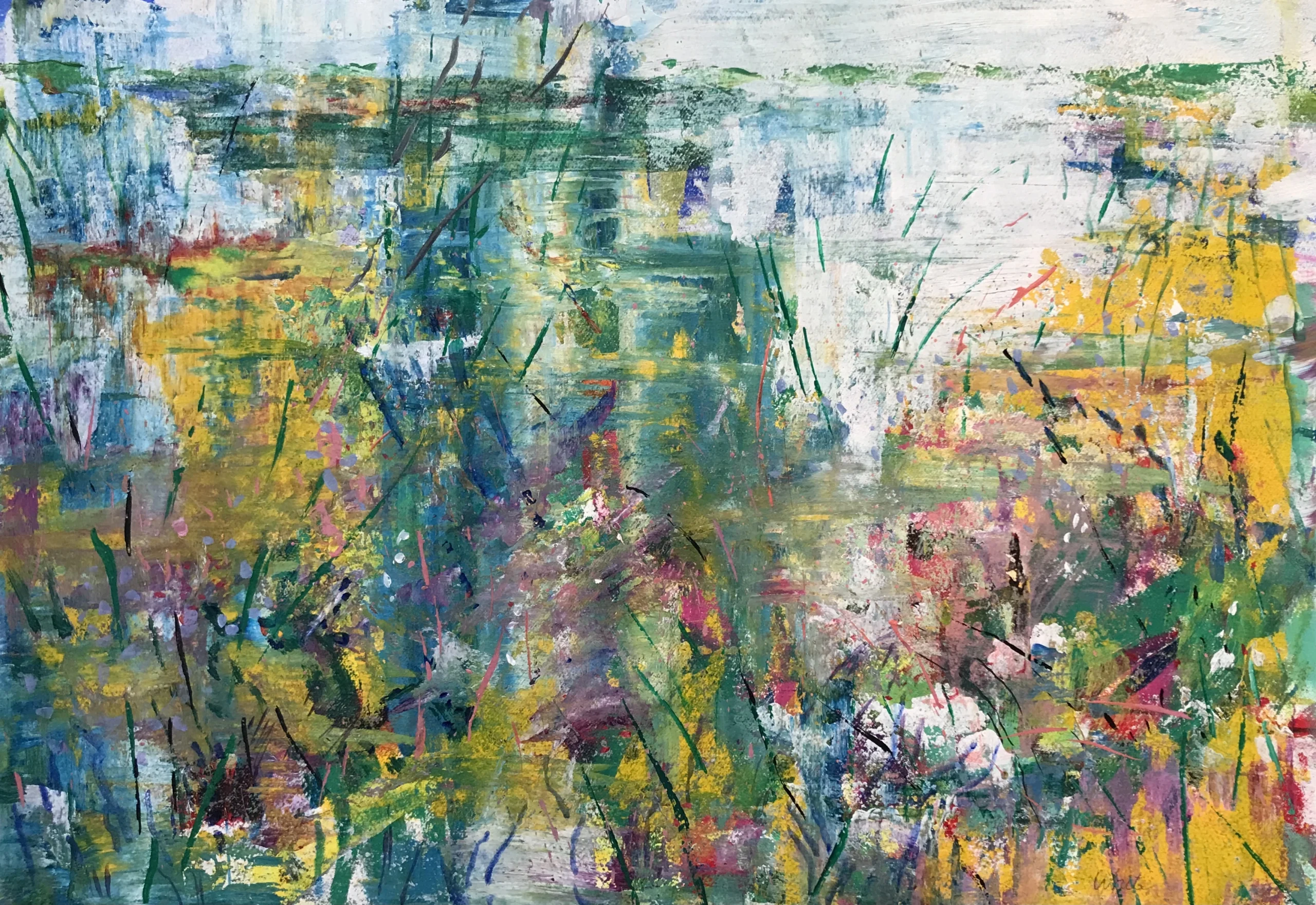A moment on a Cornwall-bound train changed everything for contemporary British artist Steve White. As he gazed out at the sea, sky, and boats, he noticed something profound about perception itself – how the movement of the train created “linear streaks” through nearby branches while distant views remained still. This revelation has transformed his artistic approach and features prominently in his current exhibition at Bear Steps Gallery.
Running from 17th to 30th August in the Main Gallery, Balcony & Link Room, Steve’s latest show presents work inspired by the Shropshire countryside, Cornwall’s coast, and his travels across Europe. We spoke with Steve about his evolving style, his relationship with landscape, and what visitors can expect from this diverse collection.
The Foundation of Drawing
Despite working across painting, etching, and lithography, Steve believes firmly that “the core of an artist’s skills is drawing.”
He explains the practical necessity:
Whilst the angle of our human vision is vast, the space on a canvas is limited so we need to scale down and be selective – drawing facilitates this.
His choice of medium depends on the subject at hand.
The linearity of etching lends itself to architectural subjects such as buildings in Venice, the softer lithography is suited to people, for example beach scenes.. Painting is suitable for any choice of subject matter and especially good for complex colourful subjects such as flora, and reflections on water.
Landscape as Endless Inspiration
Steve’s artistic practice is rooted in direct observation, beginning with “small sketches in pencil, ink, or watercolour followed by larger work in the studio.”
While he acknowledges that “painting outdoors is a challenge” – citing sun, showers, and wind that “topples the easel” – he finds that “working outdoors is ideal for quick sketches, whilst the studio offers sanctuary.“
Different landscapes demand different approaches. Cornwall’s coast intrigues him with
The transient effects of moving water, one moment a view through to sand or rocks beneath the surface, the interruption of a crashing wave and the reflections of waves or of the sky.
The Severn, closer to home, proves
Infinitely variable in different seasons and light conditions which inspires some of my most colourful abstracts.
The contrast between regions fascinates him:
In Cornwall the patterns of the low hedges, small fields and the faint curvature of the sea horizon are such a contrast to Shropshire they require a different approach.

The Severn River
A Revelation in Motion
Steve’s recent stylistic evolution stems from that transformative train journey. The experience led him to question fundamental assumptions about visual representation:
So crisp photographic realism, which dominates our lives today, typically in 35 mm lens format may not be the only way we see?
This questioning led him to consider the blurring effect that occurs naturally when we scan a view:
In the split second before our eyes settle and focus. It is sometimes inadvertently caught on camera when we release the shutter too early.
He argues that our visual experience is far richer than the fixed perspective of photography, asking whether precise photorealism might be “too narrow a definition” of how we actually perceive the world.
In the West, we read and write from left to right across the page. Automatically, our eyes start at the top left and scan to the right, down to the next line and so on. Is it so very different when we look at a painting?
These insights led to his experimental “Stripe” paintings, where “each line approximated the overall colour, the ‘mean’, of that segment.” He places this work within “a line of development seen in the work of artists such as Newman, Heron, Riley, and Richter.“
The Magic of Color
Central to Steve’s practice is his fascination with color itself: “Artists do not paint with light but with colour and that magic of mixing, juxtaposing or layering colour is for me endlessly fascinating.”
This philosophy drives his approach whether working in oils outdoors or developing larger studio pieces where “the end result, though rooted in reality, usually ends as quite abstracted from the original.“
His printmaking offers additional rewards: “Seeing a print emerge from the press is always exciting,” he says, noting how “subtle transformations occur on the dampened printing paper and further changes can be made to improve the plate.“
What Awaits at Bear Steps
The current exhibition showcases the breadth of Steve’s practice, featuring “paintings inspired by a moment when I have perceived an effect that I want to share.” Visitors will find recognizable subjects like “Tulips showing contrasting reds and greens and overlapping shapes of sunlit flowers and foliage,” alongside more abstracted works such as “the larger acrylic paintings of Venice.“
Most significantly, the show marks the first public display of his Stripe paintings,
Usually in tempera medium. Though they truthfully represent the particular landscape, the variation of colours, the overlapping lines are so abstracted they can be read, by each of us, in our own unique way.
As an added bonus, Steve has “provided a free sheet print of one such drawing for anyone to take away” – a generous gesture that allows visitors to experience his linear approach to light and texture firsthand.
Steve White’s exhibition runs until 30th August in the Main Gallery, Balcony & Link Room at Bear Steps Gallery, St Alkmund’s Place, Shrewsbury.
Open Monday-Saturday, 10am-4pm. Free admission.

